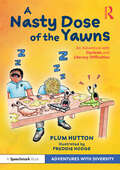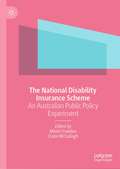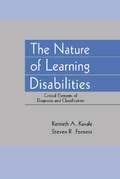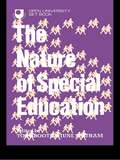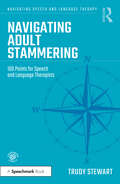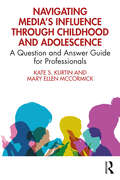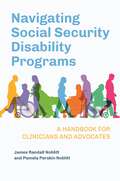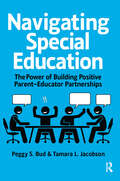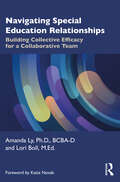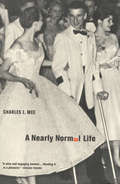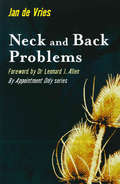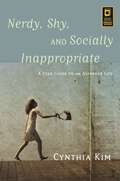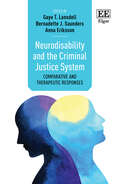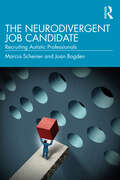- Table View
- List View
A Nasty Dose of the Yawns: An Adventure with Dyslexia and Literacy Difficulties (Adventures with Diversity)
by Plum HuttonZack has always found school difficult. Even though he is good at maths and excellent at flicking elastic bands, trying to read and write is like trying to fight a kraken. One day, when he discovers the rest of his class infected by a mysterious sleeping sickness, Zack draws on his strengths resulting in some unexpected consequences . . . This engaging story, suitable for readers aged 8–12, explores some of the challenges faced by learners who find literacy unusually difficult. Alongside the practical difficulties of living in a world that assumes good levels of literacy, it explores some of the psychological impacts of struggling to achieve a skill that most children acquire with relative ease. Ultimately, it shows children that they can draw on their strengths and overcome the challenges in their way. Also available as a set with a supporting guide, this book operates as a fun and entertaining standalone story, as well as an educational opportunity. The range of vocabulary means it can be used flexibly, for independent, paired or whole-group reading. It is a must-have book for every classroom.
The National Disability Insurance Scheme: An Australian Public Policy Experiment
by Mhairi Cowden Claire McCullaghThe National Disability Insurance Scheme (known commonly as the NDIS) was introduced as a radical new way of funding disability services in Australia. It is a rare moment in politics and policy making that an idea as revolutionary, ambitious and expensive as the NDIS makes it into its implementation phase. Not surprising, then, that the NDIS has been described by many as the biggest social shift in Australia since Medicare. This book will be a key text for scholars and public policy professionals wishing to understand the NDIS, how it was designed, and lessons learned through its introduction and roll-out. The book addresses how the NDIS has intersected with particular cohorts and sectors, and some of the challenges that have arisen. It highlights the experiences of people with disability through a collection of personal stories from participants and families in the NDIS. The key insights from this large scale public policy experiment are relevant for anyone interested in social change in Australia, or internationally.
Natural Genius: The Gifts of Asperger's Syndrome (PDF)
by Susan RubinyiNatural Genius: The Gifts of Asperger's Syndrome is Susan Rubinyi's story of raising her son Ben who has Asperger's Syndrome (AS), and how she has come to view his condition as a blessing. While acknowledging the challenges posed by AS, she emphasizes the extraordinary positives of her son's life and his particular gifts - his photographic memory, perfect pitch and French-English bilingual abilities.
The Nature of Learning Disabilities: Critical Elements of Diagnosis and Classification
by Kenneth A. Kavale Steven R. FornessThe category of learning disabilities continues to be among the most contentious in special education. Much of the debate and dissent emanates from a lack of understanding about its basic nature. The failure to evolve a comprehensive and unified perspective about the nature of learning disabilities has resulted in the concept being lost. The loss is best illustrated through the failure to answer this seemingly simple question: What is a learning disability? Using historical, empirical, theoretical, conceptual, and philosophical analyses, this volume explores a number of problems and issues facing the field of learning disabilities. The chapters cover historical influences, definitional problems, primary characteristics, assessment practices, theoretical development, major themes, research and measurement models, and long-term outcomes. The goal is to explicate the nature of learning disabilities by analyzing what it was supposed to be, what it has become, and what it might be. A predominant theme running through this text is the necessity for the field of learning disabilities to regain integrity by recapturing its essence.
The Nature of Learning Disabilities: Critical Elements of Diagnosis and Classification
by Kenneth A. Kavale Steven R. FornessThe category of learning disabilities continues to be among the most contentious in special education. Much of the debate and dissent emanates from a lack of understanding about its basic nature. The failure to evolve a comprehensive and unified perspective about the nature of learning disabilities has resulted in the concept being lost. The loss is best illustrated through the failure to answer this seemingly simple question: What is a learning disability? Using historical, empirical, theoretical, conceptual, and philosophical analyses, this volume explores a number of problems and issues facing the field of learning disabilities. The chapters cover historical influences, definitional problems, primary characteristics, assessment practices, theoretical development, major themes, research and measurement models, and long-term outcomes. The goal is to explicate the nature of learning disabilities by analyzing what it was supposed to be, what it has become, and what it might be. A predominant theme running through this text is the necessity for the field of learning disabilities to regain integrity by recapturing its essence.
The Nature of Special Education
by Tony Booth June StathamFirst published in 1981. Routledge is an imprint of Taylor & Francis, an informa company.
The Nature of Special Education: People, Places And Change (Open University Set Book Ser.)
by Tony Booth & June StathamFirst published in 1981. Routledge is an imprint of Taylor & Francis, an informa company.
Navigating Adult Stammering: 100 Points for Speech and Language Therapists (Navigating Speech and Language Therapy)
by Trudy StewartThis book, the first in an exciting new series, provides speech and language therapy students and newly qualified and beginning stammering specialists with 100 key points that will help form a strong foundation for their work supporting adults and teenagers who stammer. Composed of practical, relevant and useful advice from an experienced clinician, chapters break advice down into sections which include information about the therapeutic relationship, therapeutic approaches and signposts to further resources. Throughout the book, comments from stammering specialists describe what they wish they had known at the start of their careers. This book: Puts the person who stammers at the heart of therapy, following the clinical choices they might make Is written in an accessible style, designed to be dipped in and out of as required Draws on the experience of therapists working with those who stammer Full of advice and guidance to support effective practice, this is an essential resource for anybody new to this client group.
Navigating Adult Stammering: 100 Points for Speech and Language Therapists (Navigating Speech and Language Therapy)
by Trudy StewartThis book, the first in an exciting new series, provides speech and language therapy students and newly qualified and beginning stammering specialists with 100 key points that will help form a strong foundation for their work supporting adults and teenagers who stammer. Composed of practical, relevant and useful advice from an experienced clinician, chapters break advice down into sections which include information about the therapeutic relationship, therapeutic approaches and signposts to further resources. Throughout the book, comments from stammering specialists describe what they wish they had known at the start of their careers. This book: Puts the person who stammers at the heart of therapy, following the clinical choices they might make Is written in an accessible style, designed to be dipped in and out of as required Draws on the experience of therapists working with those who stammer Full of advice and guidance to support effective practice, this is an essential resource for anybody new to this client group.
Navigating Media’s Influence Through Childhood and Adolescence: A Question and Answer Guide for Professionals
by Kate S. Kurtin Mary Ellen McCormickNavigating Media’s Influence Through Childhood and Adolescence moves through research and questions that are relevant to practicing pediatricians and therapists in their everyday practice. As we navigate post-pandemic life where screen time was unrestricted in most homes, this book has never been more important. Written by a pediatrician and a professor of media effects, this book is a vital resource for practicing mental health clinicians, counselors, psychologists, physicians, and students studying in those areas. Grounded in developmental theory, mass communication theory, current research, and acumen gained from years of clinical and teaching experience, this book gives professionals what they need to understand the colossal effect media is having on their patients. An aid to practitioners, this book is organized by developmental stage and matches specific questions related to media’s effects with explicit research-based recommendations and explanations. It is intended to be a quick resource guide for the busy professional.
Navigating Media’s Influence Through Childhood and Adolescence: A Question and Answer Guide for Professionals
by Kate S. Kurtin Mary Ellen McCormickNavigating Media’s Influence Through Childhood and Adolescence moves through research and questions that are relevant to practicing pediatricians and therapists in their everyday practice. As we navigate post-pandemic life where screen time was unrestricted in most homes, this book has never been more important. Written by a pediatrician and a professor of media effects, this book is a vital resource for practicing mental health clinicians, counselors, psychologists, physicians, and students studying in those areas. Grounded in developmental theory, mass communication theory, current research, and acumen gained from years of clinical and teaching experience, this book gives professionals what they need to understand the colossal effect media is having on their patients. An aid to practitioners, this book is organized by developmental stage and matches specific questions related to media’s effects with explicit research-based recommendations and explanations. It is intended to be a quick resource guide for the busy professional.
Navigating PDA in America: A Framework to Support Anxious, Demand-Avoidant Autistic Children, Teens and Young Adults
by Ruth Fidler Diane GouldAlthough Pathological Demand Avoidance (PDA) has been a recognized autistic profile in the UK for some time, awareness is still growing in America. When parents first learn about it they talk about having a lightbulb moment of understanding their child better. Many described how, having found traditional parenting and behavioral techniques made things worse instead of better, they felt judged and alone. Teachers and school administrators also reported struggling to support their PDA students. The children, teens and young adults themselves were often left feeling misunderstood.The authors of this book explain PDA with an emphasis on promoting well-being both for PDA individuals and all those who support them. They provide a neurodiversity-affirming framework for supporting anxious, demand avoidant individuals across a range of settings and services. As awareness spreads across the pond, the compassion and clarity in this book will become a valuable guide to many.
Navigating Social Security Disability Programs: A Handbook for Clinicians and Advocates
by James Randall Noblitt Pamela Perskin NoblittThis book responds to a previously unmet need: unlocking the mysteries of Social Security disability programs and providing medical and mental health clinicians, as well as advocates, with the information necessary to act in the best interests of their clients.This text aims to bring clarity to medical and psychological health care providers so they better understand the importance of their role in disability determinations by familiarizing them with the benefits, limitations, and qualifications for Social Security Disability Insurance and Supplemental Security Income. Also useful for patient advocates, the authors here provide insights into the workings of Social Security, the language employed, the definitions adhered to, and the reliance on providers to respond to requests from Social Security and their patients to support their claims when warranted. Almost all medical and mental health professionals will need to interact with Social Security at some point, but will not understand the relevance or importance of their response. Much hangs on the clarity of treatment notes and opinions rendered by clinicians. Not only can their failure to respond to requests for Social Security, or to their patients in a disability case, obstruct their patients' access to benefits, it may also put a provider at risk of board censure or civil suit.
Navigating Social Security Disability Programs: A Handbook for Clinicians and Advocates
by James Randall Noblitt Pamela Perskin NoblittThis book responds to a previously unmet need: unlocking the mysteries of Social Security disability programs and providing medical and mental health clinicians, as well as advocates, with the information necessary to act in the best interests of their clients.This text aims to bring clarity to medical and psychological health care providers so they better understand the importance of their role in disability determinations by familiarizing them with the benefits, limitations, and qualifications for Social Security Disability Insurance and Supplemental Security Income. Also useful for patient advocates, the authors here provide insights into the workings of Social Security, the language employed, the definitions adhered to, and the reliance on providers to respond to requests from Social Security and their patients to support their claims when warranted. Almost all medical and mental health professionals will need to interact with Social Security at some point, but will not understand the relevance or importance of their response. Much hangs on the clarity of treatment notes and opinions rendered by clinicians. Not only can their failure to respond to requests for Social Security, or to their patients in a disability case, obstruct their patients' access to benefits, it may also put a provider at risk of board censure or civil suit.
Navigating Special Education: The Power of Building Positive Parent-Educator Partnerships
by Peggy Bud Tamara JacobsonThis timely and innovative roadmap for parents, educators, and administrators highlights the importance of effective communication methodology, appropriate correspondence, and data collection recommendations. Effective communication is often missing from the IEP team’s conversation. Navigating Special Education provides a foundation for building proactive, positive partnerships that will lead to 21st century best practices for children.The 5-C Model of Communication—Conversation, Collaboration, Cooperation, Compromise, and Consensus—presented in Navigating Special Education helps to forge trusted alliances between school districts and families.Navigating Special Education draws upon the authors’ 60-plus years of combined experience by using: Anecdotal, evidence-based, real-life scenarios Templates for letter writing and extensive data collection A user-friendly appendix and glossary As stakeholders, wouldn’t you like to have successful meetings where everyone’s voice is heard, respected, and understood? After reading Navigating Special Education, families, educational professionals, college students, and special education organizations will be able to implement effective models of communication and build positive partnerships.
Navigating Special Education: The Power of Building Positive Parent-Educator Partnerships
by Peggy Bud Tamara JacobsonThis timely and innovative roadmap for parents, educators, and administrators highlights the importance of effective communication methodology, appropriate correspondence, and data collection recommendations. Effective communication is often missing from the IEP team’s conversation. Navigating Special Education provides a foundation for building proactive, positive partnerships that will lead to 21st century best practices for children.The 5-C Model of Communication—Conversation, Collaboration, Cooperation, Compromise, and Consensus—presented in Navigating Special Education helps to forge trusted alliances between school districts and families.Navigating Special Education draws upon the authors’ 60-plus years of combined experience by using: Anecdotal, evidence-based, real-life scenarios Templates for letter writing and extensive data collection A user-friendly appendix and glossary As stakeholders, wouldn’t you like to have successful meetings where everyone’s voice is heard, respected, and understood? After reading Navigating Special Education, families, educational professionals, college students, and special education organizations will be able to implement effective models of communication and build positive partnerships.
Navigating Special Education Relationships: Building Collective Efficacy for a Collaborative Team
by Amanda Ly Lori BollTold through a series of real-life stories and hard-learned lessons, Amanda Ly and Lori Boll share the challenges in special education relationships experienced through the lens of a special educator, a parent of a son with profound disabilities, and a child psychologist.Ideally, teachers, therapists, and parents working with students with special needs should form a cohesive team. However, these three parties often function as separate entities with different goals and objectives. Over the past 25 years, the authors have observed a consistent pattern of miscommunication and overlooking the importance of the mental and physical well-being of each team member, which contributed to poor collaboration. This book takes readers on a journey through the process of discovering whether you have, or are working with, a student with special needs; navigating how to best work with the student and other members of the team; and lastly, discussing ways to empower the reader and all members of the team. The authors posit that if we understand one another's perspectives, learn how to communicate more effectively, and focus on self-care, we will increase Collective Efficacy and become the collaborative team our students need us to be.As the first book to connect the concept of Collective Efficacy to special education, this is a must-read for teachers, therapists, and parents aiming to grasp the complexities of relationships in special education teams and better understand how mental health influences the effectiveness of each individual’s role.
Navigating Special Education Relationships: Building Collective Efficacy for a Collaborative Team
by Amanda Ly Lori BollTold through a series of real-life stories and hard-learned lessons, Amanda Ly and Lori Boll share the challenges in special education relationships experienced through the lens of a special educator, a parent of a son with profound disabilities, and a child psychologist.Ideally, teachers, therapists, and parents working with students with special needs should form a cohesive team. However, these three parties often function as separate entities with different goals and objectives. Over the past 25 years, the authors have observed a consistent pattern of miscommunication and overlooking the importance of the mental and physical well-being of each team member, which contributed to poor collaboration. This book takes readers on a journey through the process of discovering whether you have, or are working with, a student with special needs; navigating how to best work with the student and other members of the team; and lastly, discussing ways to empower the reader and all members of the team. The authors posit that if we understand one another's perspectives, learn how to communicate more effectively, and focus on self-care, we will increase Collective Efficacy and become the collaborative team our students need us to be.As the first book to connect the concept of Collective Efficacy to special education, this is a must-read for teachers, therapists, and parents aiming to grasp the complexities of relationships in special education teams and better understand how mental health influences the effectiveness of each individual’s role.
Navigating the Medical Maze with a Child with Autism Spectrum Disorder: A Practical Guide for Parents
by Lisa Ford Julie O'Brien Jennifer Bain Mark D. Robinson Harumi Jyonouchi Jeffrey Kornitzer Caroline Hayes-Rosen Devorah Segal Tishi Shah Thomas Ballesteros Barbie Zimmerman-Bier Susan Brill Evan Spivack Susan Connors Iona Monterio Gary McAbeeThis practical guide contains everything parents of a child with autism need to know in order to get the best medical care for their child and to play an active and effective role in that care. It contains accessible descriptions and explanations of autism and related conditions, diagnostic tests, conventional and complementary therapies, and more.
A Nearly Normal Life: A Memoir
by Charles L. MeeIn the summer of 1953 the author was a carefree, athletic boy of fourteen. But after he collapsed during a school dance one night, he was suddenly bedridden, drifting in & out of consciousness, as his body disintegrated into a shadow of its former self. He had been stricken with spinal polio. When he emerged from the grip of the disease, he was confronted with a life change so enormous that it challenged all he had believed in & forced him, despite his young age, to redefine himself. His once stereotypically normal life, filled with baseball & swimming pools & dreams of girls, had been irreversibly altered. He was almost the same person he had been; he was nearly normal. His moving personal narrative is a textured portrait of life in the fifties - a time when America & her fighting spirit collided with this disease. Both funny & profound, he is a gifted, unique writer, who unravels the mysteries of youth in a Cold War climate, who gives voice to the mind of a child with a potentially fatal disease, & whose recognition of himself as a disabled outsider heightens his brilliant talents as a storyteller.
Neck and Back Problems: The Spine And Related Disorders (By Appointment Only Ser.)
by Jan De VriesIn Neck and Back Problems Jan de Vries deals with many of the most common problems relating to the spine. Drawing on his own vast experience of helping patients overcome their suffering and on various case histories, this book contains practical advice for those millions who endure the agony of backache. Simple exercises and remedies are outlined, together with proven hints towards self-treatment. Slipped discs, tennis elbow, 'whiplash', bursitis and problems with vertigo are all discussed in layman's terms. Neck and Back is a veritable treasure trove of information from one of the world's leading practitioners in this field.
Negotiating Disability: Disclosure and Higher Education (Corporealities: Discourses Of Disability)
by Stephanie L Kerschbaum Laura T Eisenman James M JonesDisability is not always central to claims about diversity and inclusion in higher education, but should be. This collection reveals the pervasiveness of disability issues and considerations within many higher education populations and settings, from classrooms to physical environments to policy impacts on students, faculty, administrators, and staff. While disclosing one’s disability and identifying shared experiences can engender moments of solidarity, the situation is always complicated by the intersecting factors of race and ethnicity, gender, sexuality, and class. With disability disclosure as a central point of departure, this collection of essays builds on scholarship that highlights the deeply rhetorical nature of disclosure and embodied movement, emphasizing disability disclosure as a complex calculus in which degrees of perceptibility are dependent on contexts, types of interactions that are unfolding, interlocutors’ long- and short-term goals, disabilities, and disability experiences, and many other contingencies.
Nerdy, Shy, and Socially Inappropriate: A User Guide to an Asperger Life
by Cynthia KimCynthia Kim explores all the quirkyness of living with Asperger Syndrome (ASD) in this accessible, witty and honest guide looking from an insider perspective at some of the most challenging and intractable aspects of being autistic. Her own life presents many rich examples. From being labelled nerdy and shy as an undiagnosed child to redefining herself when diagnosed with Asperger Syndrome as an adult, she describes how her perspective shifted to understanding a previously confusing world and combines this with the results of extensive research to explore the 'why' of ASD traits. She explains how they impact on everything from self-care to holding down a job and offers typically practical and creative strategies to help manage them, including a section on the vestibular, sensory and social benefits of martial arts for people with autism.Well known in the autism community and beyond for her popular blog, Musings of an Aspie, Cynthia Kim's book is rich with personal anecdotes and useful advice. This intelligent insider guide will help adults with ASDs and their partners, family members, friends, and colleagues, but it also provides a fresh and witty window onto a different worldview.
Neurodisability and the Criminal Justice System: Comparative and Therapeutic Responses
This thought-provoking book highlights the increasing recognition of the prevalence of neurodisability within criminal justice systems, discussing conditions including intellectual, cognitive and behavioural impairments, fetal alcohol spectrum disorders and traumatic and acquired brain injury. International scholars and practitioners demonstrate the extent and complexity of the neurodisability experience and present practical solutions for criminal justice reform.Examining the growing body of evidence which illustrates the significant over-representation of neurodisability amongst prison and juvenile justice populations, this critical book explores the challenges faced by people with a neurodisability who come into contact with the justice system. These challenges include: difficulty understanding interactions with police, navigating court processes, comprehending sentencing orders, and coping with prison and post-release life, which can lead to repeat victimisation and criminalisation. Overall, this book establishes that justice systems are often unable to meet the specific needs of people with a neurodisability and that there is a significant lack of appropriate support within the community aimed at prevention and diversion.Providing broad interdisciplinary insights, this timely book will prove a vital resource for scholars and students of criminal law, law and society, criminology, neuroscience and social work. It will also be of value to legal practitioners, law enforcement, prison employees and welfare professionals engaged with individuals with a neurodisability.
The Neurodivergent Job Candidate: Recruiting Autistic Professionals
by Joan Bogden Marcia ScheinerThis book provides guidance on recruiting, interviewing, and onboarding practices that will allow employers to successfully hire neurodivergent professionals into inclusive, competitive employment. Today, 35% of 18-year-olds with an autism spectrum diagnosis attend college, yet they have a 75–85% under-employment and unemployment rate after graduation. While organizations are looking to expand their diversity and inclusion hiring efforts to include neurodivergent professionals, current recruiting and interviewing practices in general are not well-suited to this. With over one-third of the US population identifying as neurodivergent, employers need to address how to attract this talent pool to take advantage of a meaningful segment of the workforce. Readers of this book will gain an understanding of how to guide their organizations through the creation of recruiting, interviewing, and onboarding processes tailored to neurodivergent professionals in any field. Written by authors with extensive experience working in the corporate world and consulting with Fortune 1000 companies on autism hiring efforts, this book is targeted at employers, acknowledging their perspective. Structured as a reference guide for busy recruiters, hiring managers, and supervisors, this book can be read in its entirety, in relevant sections as needed, or used as a refresher whenever necessary. This book also provides a background on the thinking styles of autistic individuals, giving the reader a deeper understanding of how to best support neurodivergent jobseekers.
